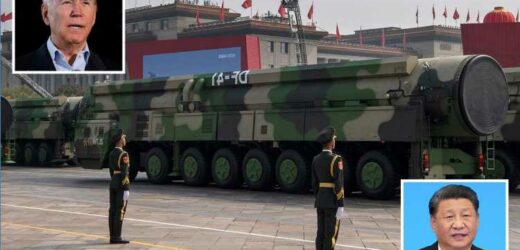CHILLING satellite pictures taken last month revealed that China is building up to 120 new nuclear launch sites in what experts call a “breathtaking expansion” of the nation’s ballistic missiles.
The worrying intelligence that China is rapidly expanding its arsenal has left analysts debating the best course of action from the United States, as some argue that it should prompt a rapid resumption of arms-control talks.
The Washington Post reported in June that Beijing is building more than 100 additional missile silos in the country's northwestern Gansu province, covering a whopping 700-square-mile radius.
The silos were first identified by researchers at the Center for Nonproliferation Studies at a site where there were previously only 16 silos reported.
These silos can hold China's newest nuclear-armed missile, the DF-41.
Reports also say underground bunkers are being built to function as launch centers, with trenches carrying cables to 10 different silo launchers.
Not every one of these new silos is expected to house missiles, experts say, yet they insisted that the US must act to ensure its authority.
They say the solution is arms-control talks with Beijing. This doesn’t make sense.
Matthew Kroenig, a former senior policy adviser for nuclear and missile-defense policy in the Office of the Secretary of Defense, hit out at claims that it should spark an attempt to make an arms-control deal with China.
“The arms-control proponents say we should not panic and that these new silos are meant only to ensure that China’s nuclear weapons can survive a US nuclear first strike," he wrote in the Wall Street Journal.
"They say the solution is arms-control talks with Beijing.
“This doesn’t make sense," he blasted.
Instead, Kroenig argued: “China is engaging in a massive nuclear-arms buildup as part of its broader strategy to challenge the US-led rules-based international system, and the US will need to respond by updating its nuclear program to defend itself and the free world."
“This buildup could make China a nuclear peer with the U.S. and Russia, which each maintain no more than 1,550 strategic nuclear weapons, per New Start Treaty limits,” he added.
'CHINA NOT A LESS POWER'
Kroenig went on to warn that it means "for the first time in history, the US will have to contend with two adversaries with substantial nuclear arsenals.
“Sizing the U.S. nuclear force for parity with Russia and treating China as a lesser power will no longer work,” Kroenig warned.
"They have urged caution in presuming that China is expanding its nuclear capabilities dramatically and noted that it is likely an attempt to catch up with the US’s cache."
James M. Acton, co-director of the Nuclear Policy Program at the Carnegie Endowment for International Peace, has argued against this, claiming that there are many reasons why the expansion is no cause to panic.
He wrote in an op-ed for the Washington Post that some of the new silos are likely to be decoys with no missiles.
“China has built a vast network of tunnels to help hide, and therefore protect, its relatively small force of mobile ICBMs. In a similar vein, some of the new silos may be dummies, intended to complicate U.S. targeting plans,” Acton said.
“In fact, China may even plan to shuttle a small number of ICBMs among a much larger number of silos in a kind of 'shell game'."
To counter this challenge, the US will need to strengthen its nuclear arsenal.
This is an approach that had been adopted by the US during the Cold War when the Carter administration planned 4,600 silos to protect only 200 MX/Peacekeeper ICBMs, he explains.
Acton also cautioned that China’s motivation in building the silos is “important in developing an effective response.”
He adds that the US “is likely to retain a much larger nuclear arsenal than China” but that the US could head off a potential arms race by tracking fissile material – the plutonium and highly enriched uranium needed to produce nuclear weapons.
“China does not currently appear to be producing more fissile material, though there are concerns that it may restart,” he states.
Yet Koening argued again that the approach to China needs to be “realistic.”
“To counter this challenge, the US will need to strengthen its nuclear arsenal,” he said.
"Arms control can be pursued, but we have to be realistic. China has no history of negotiating constraints on its nuclear forces and it is unlikely to start now, during a massive expansion of its program."
It comes as China is building up a terrifying arsenal of weapons including hypersonic missiles that travel so fast they are impossible to stop.
The DF-17 can perform “extreme maneuver” as it moves at Mach 10 – some 7,600mph – towards a target, with a carrier unlikely to survive a direct hit.
Their sophisticated sensors, guidance systems, and innovative propulsion methods have been compared to building the atomic bomb.
Commander of US Strategic Command Charles A. Richard has warned that China’s nuclear arsenal could double, if not triple or quadruple, in the next decade.
Source: Read Full Article






